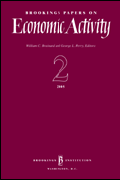Studies in this week’s Hutchins Roundup find that experience from hurricanes suggests post-Covid rebound in elective hospital visits will take years, college graduates who entered the job market after the Great Recession continue to face obstacles, and more.
Want to receive the Hutchins Roundup as an email? Sign up here to get it in your inbox every Thursday.
Experience from hurricanes suggests post-Covid rebound in elective hospital visits will take years
How quickly will demand for elective visits to hospitals bounce back after the COVID-19 pandemic recedes? To begin to answer this question, Tatyana Deryugina from the University of Illinois, Jonathan Gruber from MIT, and Adrienne Sabety from NBER look at what happened to Medicare hospital elective visits after hurricanes that hit between 1997 and 2012. By comparing counties impacted by hurricanes to nearby unaffected counties, they find that hurricanes cause a significant decline in the provision of hospital elective services. For the average hurricane, the drop is roughly 7%, and hospitals are able to make up for their revenue losses 10-11 months later. For the most severe hurricanes, the drop is more than 20%, and financial losses are, at best, made up within 12 months, if at all. Moreover, the recovery in elective services is much larger for outpatient than inpatient elective care. In particular, for the strongest hurricanes, they find that the losses from inpatient elective care have the potential to be long-lasting. Finally, comparing the effect of COVID-19 to an equivalently severe hurricane, the authors project that it will take more than three years for providers to make up for the lost revenue from COVID-19.
College grads who entered job market after Great Recession face persistent obstacles
Jesse Rothstein from the University of California, Berkeley, finds that college graduates who entered the labor market during the long period of sluggish economic growth following the Great Recession had “trouble finding toeholds on job ladders and generally have had poor outcomes.” Although employment rates rose dramatically following the Great Recession for incumbent workers, new entrants did not share in this improvement. The average employment rate from 2010 to 2019 for college graduates who entered the labor market in 2010 is two percentage points lower than what would have been expected based on the experience of prior cohorts and the state of the economy. Workers in this cohort have also had lower wages than those who entered earlier, by about 2%. This trend shows no sign of letting up. The employment rate of graduates who entered the labor market in 2015 is three to four percentage points lower than what one would have anticipated based on the pre-2005 trend. The author concludes that there was a structural break in the labor market around 2005 that lowered employment rates of new college graduates, and the long, steady recovery of the 2010s did not fix it.
High loan-to-value mortgages do not explain the 2008 housing crisis
Conventional wisdom is that the housing boom of the 2000s was in large part the result of making mortgages to buyers with little equity or high loan-to-value (LTV) ratios. However, Manuel Adelino at Duke University, William B. McCartney at Purdue University, and Antoinette Schoar at MIT find that the distribution of loan-to-value ratios of mortgages in the United States remained relatively stable between 1996 and 2015. Using data on deeds from county recorders’ offices, the authors do not find a shift towards very high LTV ratios, nor a change in the distribution of the age or size of the houses, the types of borrowers, or their ZIP codes. However, they do find that privately securitized high-LTV loans replaced government-backed high-LTV loans at a rate of nearly one-to-one during the housing boom, and a corresponding reversal to government-backed loans after 2008. The authors also find that the shift to privately backed high-LTV loans followed rather than led the trend in rising house prices. The authors conclude that these findings favor models of housing booms that operate through changes in collateral values or house price expectations, rather than leverage channels.
Chart of the week: Number of people receiving benefits falls to lowest level since April
Quote of the week:
“The COVID-19 contraction is unprecedented in modern times for its severity and speed. Following the deepest plunge since the Great Depression, employment and activity rebounded faster and more sharply than anticipated. But the recent resurgence in COVID cases is a sober reminder that the pandemic remains the key driver of the economy’s course. A thick fog of uncertainty still surrounds us, and downside risks predominate. The recovery is likely to face headwinds even if the downside risks do not materialize, and a second wave would magnify that challenge. Fiscal support will remain vital…” says Lael Brainard, member of the Federal Reserve Board of Governors.
“As we move to the next phase of monetary policy, we will be guided not only by the exigencies of the COVID crisis, but also by our evolving understanding of the key longer-run features of the economy, so as to avoid the premature withdrawal of necessary support. Because the long-run neutral rate of interest is quite low by historical standards, there is less room to cut the policy rate in order to cushion the economy from COVID and other shocks. The likelihood that the policy rate is at the lower bound more frequently risks eroding expected and actual inflation, which could further compress the room to cut nominal interest rates in a downward spiral. With underlying inflation running below 2% for many years and COVID contributing to a further decline, it is important that monetary policy support inflation expectations that are consistent with inflation centered on 2% over time. And with inflation exhibiting low sensitivity to labor market tightness, policy should not preemptively withdraw support based on a historically steeper Phillips curve that is not currently in evidence. Instead, policy should seek to achieve employment outcomes with the kind of breadth and depth that were only achieved late in the previous recovery.”











Commentary
Hutchins Roundup: Elective hospital visits, Great Recession college grads, and more
July 16, 2020